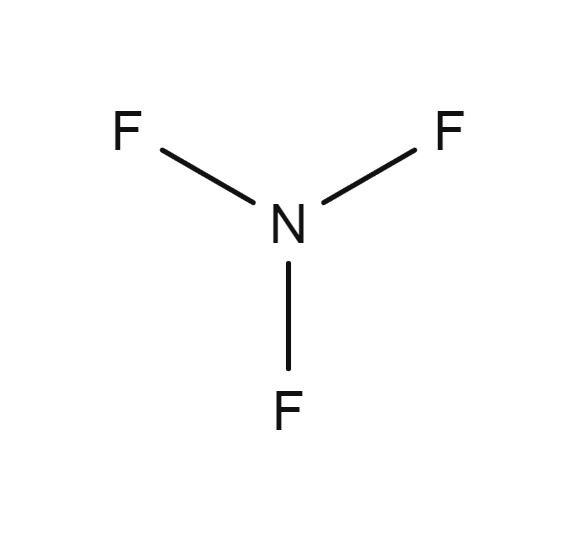
Nitrogen trifluoride
- NF3
- CAS Number 7783-54-2
- UN2451 (gas)
Click & drag to move the 3D molecule
Liquid / Gas Volumes
Calculate the volume or mass of a quantity of gas or liquid
Liquid Phase
At boiling point at 1.013 bar
Gas Phase
In standard conditions (1.013 bar, 15°C)
Physical Properties
Molecule phase diagram showing the transition phases between solid, liquid and gas as a function of temperature and pressure
-
- Molar mass 71.019 g/mol
- Content in dry air /
-
Critical Point
- Temperature -39.15 °C
- Pressure 44.607 bar
- Density 597.91 kg/m³
-
Triple Point
- Temperature -206.69 °C
- Pressure 1.854E-6 bar
Pressure 1.013 bar
| Latent heat of fusion (at melting point) | 5.603 kJ/kg |
| Melting point | - 206.69 °C |
Pressure 1.013 bar
| Boiling point | - 129.01 °C |
| Latent heat of vaporization (at boiling point) | 162.708 kJ/kg |
| Liquid density (at boiling point) | 1537.863 kg/m3 |
| Compressibility factor Z | 9.9515E-1 |
| Cp/Cv ratio γ | 1.1996 |
| Gas density (at boiling point) | 6.239 kg/m3 |
| Gas density | 3.184 kg/m3 |
| Gas/(liquid at boiling point) equivalent | 488.486 vol/vol |
| Heat capacity Cp | 7.1941E-1 kJ/(kg.K) |
| Heat capacity Cv | 5.9972E-1 kJ/(kg.K) |
| Specific gravity | 2.46 |
| Specific volume | 3.141E-1 m3/kg |
| Thermal conductivity | 16.023 mW/(m.K) |
| Viscosity | 1.8123E-4 Po |
| Compressibility factor Z | 9.9594E-1 |
| Cp/Cv ratio γ | 1.1921 |
| Gas density | 3.0158 kg/m3 |
| Gas/(liquid at boiling point) equivalent | 515.72 vol/vol |
| Heat capacity Cp | 7.4054E-1 kJ/(kg.K) |
| Heat capacity Cv | 6.2121E-1 kJ/(kg.K) |
| Specific gravity | 2.46 |
| Specific volume | 3.316E-1 m3/kg |
| Thermal conductivity | 17.195 mW/(m.K) |
| Viscosity | 1.902E-4 Po |
| Compressibility factor Z | 9.9639E-1 |
| Cp/Cv ratio γ | 1.1876 |
| Gas density | 2.9134 kg/m3 |
| Gas/(liquid at boiling point) equivalent | 533.85 vol/vol |
| Heat capacity Cp | 7.5425E-1 kJ/(kg.K) |
| Heat capacity Cv | 6.3511E-1 kJ/(kg.K) |
| Specific gravity | 2.46 |
| Specific volume | 3.432E-1 m3/kg |
| Thermal conductivity | 17.979 mW/(m.K) |
| Viscosity | 1.961E-4 Po |
Applications
Examples of uses of this molecule in Industry and Healthcare

Electronic components
In silicon thin film photovoltaic, semiconductor and display fabrication, nitrogen trifluoride is used as a fluorine source to clean Chemical Vapor Deposition (CVD) reactors. It is also a selective reagent for silicon dioxide etching.
Safety & Compatibility
GHS03
Oxidising
GHS04
Gas under pressure
GHS07
Health hazards
Threshold of toxicity
| PEL USA OSHA (vol) | 10 ppm |
| VLEP 8h France (at Patm and 293.15 K) | 30 mg/m3 or 10 ppm |
Odor
Moldy
Metals
| Aluminium | Satisfactory |
| Brass | Satisfactory |
| Monel | No data |
| Copper | No data |
| Ferritic Steel | Satisfactory |
| Stainless steel | Satisfactory |
| Zinc | No data |
| Titanium | No data |
Plastics
| Polytetrafluoroethylene | Satisfactory |
| Polychlorotrifluoroethylene | Satisfactory |
| Polyvinylidene fluoride | Satisfactory |
| Polyvinyl chloride |
Violent reaction (oxidation/burning)
Not recommended
|
| Ethylene tetrafluoroethylene | No data |
| Polycarbonate | No data |
| Polyamide |
Violent reaction (oxidation/burning)
Not recommended
|
| Polypropylene |
Violent reaction (oxidation/burning)
Not recommended
|
Elastomers
| Butyl (isobutene- isoprene) rubber |
Violent reaction (oxidation/burning)
Not recommended
|
| Nitrile rubber |
Violent reaction (oxidation/burning)
Not recommended
|
| Chloroprene |
Violent reaction (oxidation/burning)
Not recommended
|
| Chlorofluorocarbons | No data |
| Silicone |
Violent reaction (oxidation/burning)
Not recommended
|
| Perfluoroelastomers | Satisfactory |
| Fluoroelastomers | Satisfactory |
| Neoprene | No data |
| Polyurethane |
Violent reaction (oxidation/burning)
Not recommended
|
| Ethylene-Propylene |
Violent reaction (oxidation/burning)
Not recommended
|
Lubricants
| Hydrocarbon based lubricant |
Violent reaction (oxidation/burning)
Not recommended
|
| Fluorocarbon based lubricant | Satisfactory |
Materials compatibility
Learn More
More information
After first attempting the synthesis in 1903, Otto Ruff obtained nitrogen trifluoride by the electrolysis of a molten mixture of ammonium fluoride